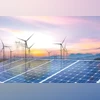)
An inability to accurately forecast the weather makes it difficult to optimise renewable energy production and can influence safety and profitability of projects |
India needs to upgrade the way it monitors weather so its clean energy infrastructure can reach its full potential, according to industry leaders.
“Our understanding of weather is not as good as it needs to be,” Amit Singh, chief executive of Adani Green Energy Ltd., said at the annual BloombergNEF Summit in New Delhi on Thursday. Low weather station density and infrequent measurements have contributed to wind farms’ lackluster performance in India, he said.
An inability to accurately forecast the weather makes it difficult to optimise renewable energy production and can influence safety and profitability of projects, said Yogesh Patil, CEO of forecaster Skymet Weather Services. This can strain the grid, among other impacts.
Existing weather models are “nowhere close to what we need for doing a very good quality micro siting,” which establishes the optimal location for a windmill, according to Singh. “The industry needs to work together and develop a robust system for dust movement predicting and wind change in the short and longer term,” he said, adding that Adani Green has brought up the issue with Indian authorities.
As it strives to reduce the carbon intensity of its economy, India will need to increase the share of renewables in its coal-heavy energy basket, but it is already facing constraints. Its rapid economic development is driving the fastest growing electricity demand among all major economies. And with around 205 gigawatts of installed non-fossil capacity, it remains far from reaching the 500 gigawatts it seeks to achieve by the end of the decade.
Scarce land and booming demand are why wind and solar now need to be deployed in hard-to-reach locations like offshore or in the northern Ladakh territory, said Sumant Sinha, chairman of the renewable energy company ReNew Energy Global Plc.
Better understanding of the weather will become increasingly important as India embarks on a more challenging stage of its renewables expansion, said Abhishek Raju, founder of the geospatial data analytics company SatSure.
“We need better weather modeling in remote areas where typically legacy weather models didn’t exist, and the government should take the lead on building them” and making them available to investors in the renewable space, he said.
First Published: Sep 06 2024 | 9:43 AM IST


































